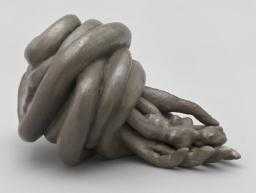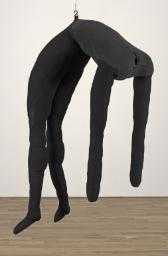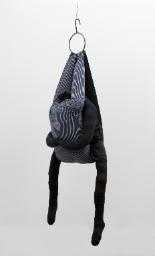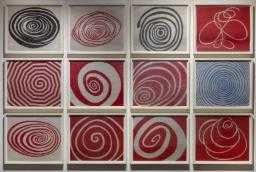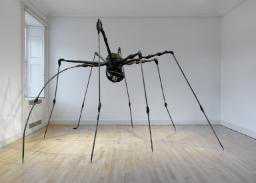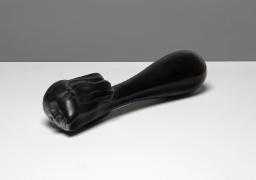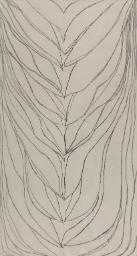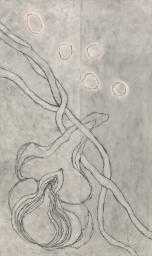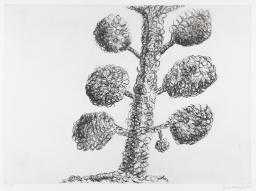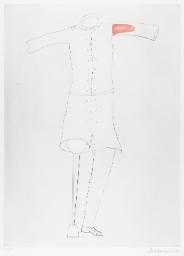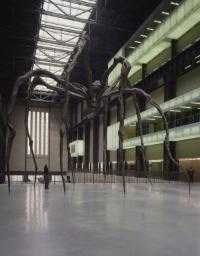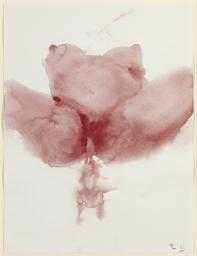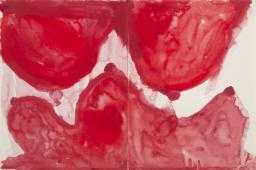
Not on display
- Artist
- Louise Bourgeois 1911–2010
- Medium
- Bronze, silver nitrate patina
- Dimensions
- Object: 86 × 596 × 127 mm, 6 kg
- Collection
- ARTIST ROOMS
Tate and National Galleries of Scotland. Lent by Artist Rooms Foundation 2013
On long term loan - Reference
- AL00343
Summary
Give or Take is a bronze sculpture with a silver nitrate patina. It depicts an outstretched and closed hand, connected to form a single entity. The object appears to be two forearms fused together, one blending into the other, but is otherwise disembodied. The work was made by Louise Bourgeois in 2002 by casting the hands and forearms of her longtime assistant Jerry Gorovoy. Gorovoy was a frequent model for Bourgeois’s works, particularly those which feature hands. Another bronze sculpture, The Welcoming Hands 1996 (Jardin des Tuileries, Paris) for instance, shows the artist’s hands clutching those of Gorovoy and in the series of drawings 10am is When You Come to Me 2006 (Tate AL00345) their hands reach out, meet and interact in a reflection on their friendship and working relationship. Bourgeois met Gorovoy in the late 1970s: he was her assistant, close friend and confidant for over thirty years.
As the title suggests, the hands in Give or Take visualise the physical acts of giving and taking. The outstretched hand appears to offer support, comfort and reassurance, as well as suggesting loneliness: while the closed hand appears to deny human contact suggesting withdrawal or contentment. Hands occur frequently in Bourgeois’s work, often as symbols of support and dependence, such as in Nature Study 1986 (Tate AL00228). Give or Take, however, presents a far more ambiguous view of human relationships. Rather than show the interaction between two bodies, this single limb uncannily represents two opposing gestures, perhaps referring to the experience of sustaining contradictory feelings and desires, a theme Bourgeois had explored before in her important sculpture Janus Fleuri from 1968 (Tate AL00347).
Despite the singularity of the object, the ‘giving’ and ‘taking’ hands might also be seen as oppositional. That these hands could never embrace, seems to indicate that the apparently symbiotic actions of giving and taking are rarely reciprocal. This is echoed in the artist’s decision to title the work Give or Take, rather than follow the form of the commonplace phrase ‘give and take’. Whereas the latter suggests cooperation and mutual understanding, the work’s title proposes an ultimatum, between two irreconcilable positions.
This work may also be seen to exemplify a ‘part-object’, a term used by psychoanalysts such as Melanie Klein to refer to parts of the body that attest to physical and emotional relationships between infants and adults. The art historian Mignon Nixon has written on the subject of the part-object and its influence on Bourgeois’s work: ‘Klein contends that the subject first relates to its environment as a field of objects (called part-objects) to be fused or fragmented, possessed or destroyed, by means of phantasies of introjection, projection and splitting that are themselves produced by the drives.’ (Nixon 2005, p.8.) Nixon argues that by fragmenting parts of the body, Bourgeois represents the complex array of emotional states that structure our identities and relationships.
Further reading
Mignon Nixon, Fantastic Reality: Louise Bourgeois and a Story of Modern Art, Cambridge, Massachusetts and London 2005.
Francis Morris (ed.), Louise Bourgeois, exhibition catalogue, Tate Modern, London 2007, reproduced p.63.
Lucy Askew and Anthony d’Offay, Louise Bourgeois: A Woman Without Secrets, exhibition catalogue, National Galleries of Scotland, Edinburgh 2013, pp.58, 85, reproduced p.59.
Allan Madden
The University of Edinburgh
November 2014
The University of Edinburgh is a research partner of ARTIST ROOMS
Does this text contain inaccurate information or language that you feel we should improve or change? We would like to hear from you.
You might like
-
Louise Bourgeois Nature Study
1986 -
Louise Bourgeois Single II
1996 -
Louise Bourgeois Couple I
1996 -
Louise Bourgeois Spirals
2005 -
Louise Bourgeois Spider I
1995 -
Louise Bourgeois Spider
1994 -
Louise Bourgeois Fallen Woman
1981 -
Louise Bourgeois The Smell of Eucalyptus (#2)
2006 -
Louise Bourgeois Love and Kisses
2007 -
Louise Bourgeois Tree
1998 -
Louise Bourgeois Amputee with Peg Leg
1998 -
Louise Bourgeois Maman
1999 -
Louise Bourgeois The Birth
2007 -
Louise Bourgeois The Family
2008 -
Louise Bourgeois The Friendly Landscape
2008

